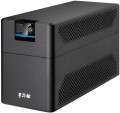Full load operating time
UPS continuous operation time from a fully charged battery when connected to a load with a power equal to the UPS output power (maximum or effective, depending on the type of load, see the relevant paragraphs for details). For a UPS designed to work with a home or office PC, a time of about 10-15 minutes is considered sufficient, this is enough to save data and complete work. To power servers, it is worth using devices with an operating time
of 20 minutes or more.
Half load operating time
UPS continuous operation time from a fully charged battery when connected to a load with a power equal to half the output power of the UPS (maximum or effective, depending on the type of load, see below for details). The operating time with such a load is much longer than for a full load, and even in the simplest models it can reach 20-30 minutes.
Output waveform
The form of a graph describing the changes in voltage at the output of the UPS.
—
Pure sinewave. The classic AC voltage graph, this is how it changes in an AC network; The sine wave output means that the UPS has little to no distortion compared to the mains. As a result, such power is suitable for any AC technology, and some devices (for example, audio equipment) generally require an exceptionally pure sine wave. However, this requires rather complex technical solutions, and therefore this waveform can be found in expensive interactive and inverter UPSs.
—
Simulated sine wave (approximated). This signal has a shape close to a sinusoid, but the graph line in this case is not smooth, but consists of separate rectangular “steps”. This waveform is provided by most inexpensive UPSs; such devices are inexpensive and quite suitable for powering computer equipment.
Control interfaces
Many modern UPSs can be connected to a computer or other special devices. This provides advanced options for monitoring the parameters of the UPS and managing its functions: without leaving the computer, you can monitor the battery status, network parameters, load, enable special modes, apply automatic adjustment, etc. Such a connection can be made according to the following standards:
—
RS-232. It's a COM port. Initially designed to connect various peripherals to a computer. Today it is also quite widespread, however, due to its relatively large size, it is installed mainly on stationary PCs.
—
USB. A universal port for connecting various peripherals to a computer, the most popular interface of this kind today — at least one USB port has an absolute majority of computers and laptops.
-LAN. A port used to connect to wired computer networks. Models with this interface can often be connected as a network device, which allows, if necessary, to control them from any computer on this network.
—
SmartSlot. A slot in the UPS case for installing expansion cards (SmartSlot cards). The development of APC, is used mainly in the devices of its production. Such cards can provide a very diverse set of features: additional connection ports beyond the standard ones (for example, a LAN control port), a web managemen
...t interface, support for SNMP, Secure HTTP and other protocols, connection of temperature / humidity sensors, and much more. To date, a wide range of cards is being produced, making it easy to choose a set of additional functions depending on the specific situation. Most UPS models have one SmartSlot, but if necessary, you can use a special expander and install two cards, and the largest models can have two slots as standard.
— "Dry contact". In uninterruptible power supplies, the term "dry contact" refers to a professional interface used to transfer data on the operation of the UPS to specialized external equipment. Such an interface usually has a whole set of contacts (on the order of 10), often in the form of terminals. And the scheme of its operation can be simply described as follows: when certain parameters are reached, the control relay closes or opens a given set of “dry contacts”, on the basis of which the control device receives information about one or another parameter of the UPS operation.
